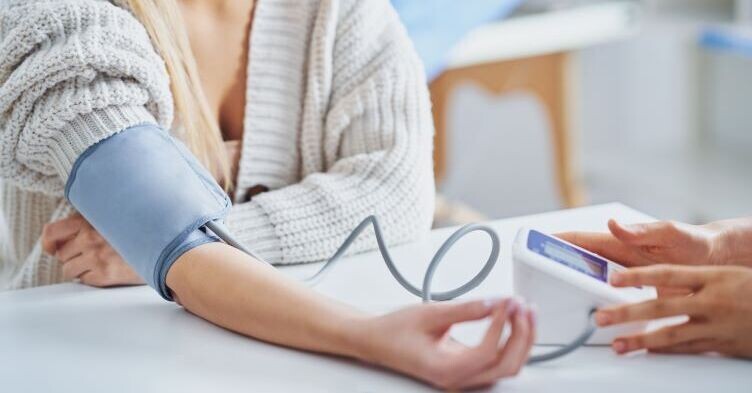Mythbuster: ‘Women who are taking HRT can’t get pregnant’

GP Dr Toni Hazell explains that it is a myth that women on HRT cannot become pregnant and so still need contraceptive advice during perimenopause and when taking HRT.
The menopause is defined as ‘a biological stage in a woman’s life when menstruation stops permanently due to the loss of ovarian follicular activity… usually diagnosed clinically after 12 months of amenorrhoea’. Before the menopause comes the perimenopause, also known as the climacteric; during perimenopause a woman’s cycles will become irregular and they may have symptoms such as hot flushes, night sweats and fatigue.1
The menopause and perimenopause are diagnosed clinically, with a blood test not being needed unless the woman is under 45.2 NICE advises that we should offer hormone replacement therapy (HRT) for women with vasomotor symptoms (hot flushes and night sweats). It is a common myth that it is difficult, or impossible, to get pregnant once you have started having symptoms of the perimenopause but this is not true.
The reality
Related Article: Diagnosis Connect service will link people to advice from charities
The Faculty of Sexual and Reproductive Healthcare (FSRH) reminds us that ‘although a natural decline in fertility occurs with age and spontaneous pregnancy is rare after age 50, effective contraception is required until menopause to prevent an unintended pregnancy’.3 This means that there will be a cohort of women who are using HRT for symptoms of the perimenopause, but who still need adequate contraception if they are sexually active.
Some women will welcome a pregnancy in their 40s, but for others a pregnancy might be unwanted, for example if they already have children who have left home. The FSRH notes that in 2015, over one-quarter of pregnancies in women aged over 40 living in England or Wales ended in termination and that 4% of all terminations in Scotland in 2016 were to women in this age group. This may partly reflect the increased risk of chromosomal abnormalities at this age and the increased risks of pregnancy for the woman, compared to a pregnancy at a younger age3. One study on the reasons for second trimester terminations shows that around half of women who presented late in pregnancy did so because their periods were irregular4 and therefore they didn’t think to do a pregnancy test. It is therefore really important that we educate perimenopausal women about their risks of pregnancy, so that they can take steps to use contraception if needed, and that if termination is the right thing for a woman, she knows that she is pregnant at the earliest possible opportunity.
How to advise on contraception
We need to consider some different issues in advising women over 40 about contraception, compared with when advising younger women. Certain methods may become unsafe – for example, combined hormonal contraception (CHC) is relatively contraindicated when a woman turns 40. Age alone is not necessarily a reason to stop prescribing it, but if there are other related contraindications such as a raised BMI or high blood pressure, then the combined risk might be unacceptable. If a woman does continue on CHC in her 40s then the oestrogen in the CHC may mask the symptoms of the menopause.
We have seen that the menopause is a clinical diagnosis made after a year of amenorrhoea. This is made more complicated in women who are using contraceptive methods which cause amenorrhoea, such as the implant, the intra-uterine system and some types of pill. How does a woman know if her lack of periods is due to the contraception, which she therefore needs to continue, or is due to the menopause, in which case she could stop using contraception? Women in this situation have two options. They can continue their method until the age of 55, after which conception is ‘exceptionally rare’.3 Alternatively, once a woman reaches the age of 50 she could ask to have her follicle stimulating hormone (FSH) checked. If it is found to be in the menopausal range, then the date of the test can be taken as analogous to the date of the last period – she should use contraception for one more year and can then stop.3 This does not work for women using CHC, but CHC is contraindicated over the age of 50 and so it should not be an issue.
The final thing to consider is how you manage prescribing of both HRT and contraception, which may require the use of more than one hormonal preparation. A woman who still has her uterus will need a combined method of HRT, containing oestrogen and a progestogen. However many forms of HRT are not in themselves contraceptive. The simplest method to solve both problems is to use the Mirena intra-uterine system (IUS), which has a licence both as the progestogenic component of HRT and for contraception. At the time of writing, no other brand of IUS has this HRT licence. The Mirena licence for HRT is only for four years, but FSRH guidance supports its use for this purpose for five years, the same as the licence for contraception.3 If the woman does not want an IUS then it is fine for her to use another progesterone only method alongside her HRT, for example the pill or the implant (ideally not the depot past the age of 50).
A woman who is past her menopause can’t conceive – she has moved away from the reproductive phase of her life. But many women with menopausal symptoms will still be at risk of pregnancy and we must make them aware of this, so that informed decisions can be made which are right for the individual woman and her family.
Related Article: CVD prevention must be national health priority, says report
References
(All urls accessed July 2022)
1. NICE CKS. Menopause. March 2022
2. NICE NG23. Menopause: diagnosis and management. December 2019
Related Article: Postnatal contraception advice reduces the risk of back-to-back pregnancies
3. FSRH Clinical Guideline: Contraception for women aged over 40 years. September 2019
4. Ingham R, Lee E, Clements S et al. Reasons for second trimester abortions in England and Wales. Reprod Health Matters 2008;16(31 Suppl):18-29

See how our symptom tool can help you make better sense of patient presentations
Click here to search a symptom




